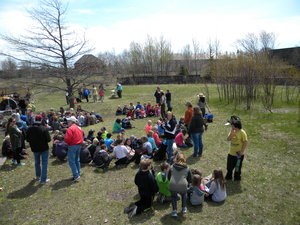
NPS Photo Explore the diverse activity stations from the 2019 event. These stations all connect with the topics of TRACES (Technology, Research, Art and music, Community, Environment, and Service), as well as Michigan Grade Level Content Expectations. 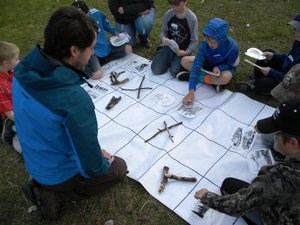
NPS Photo Landscape Uses and Development in the KeweenawLet's build a community! In this station students will work together to design their ideal place to live, play, and work. How will our region's historic background and unique landscape features shape the world we live in today? Time to experiment and find out! 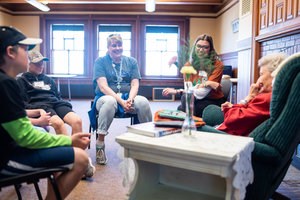
NPS Photo: Victor Ierulli II You've Got a Friend in MeSometimes it can be difficult to start a conversation with someone you do not know, especially if they are a different age from you. How do you start a conversation with this person? What do you talk about? Students will participate in a simulated home visit with local elderly to learn inclusivity, friendship, and empathy. Self-reflection will empower and encourage students to practice kindness in their everyday environment and interactions.Michigan Standards 4-P3.1.1, 4-P4.2.1, 4-P4.2.2, SL.4.1a-d, SL.4.3 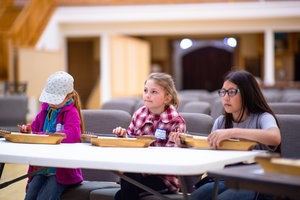
NPS Photo: Victor Ierulli II Five Strings, Five Notes: Learn to Play the KanteleThe Finnish were and continue to be a significant immigrant group to the Keweenaw Peninsula. Their cultural influence remains today in foods (nisu), names (Maki), traditions (sauna), churches (Lutheran), music (kantele and dance), and even attitudes (sisu!). At this station, students will have an opportunity to explore one aspect of Finnish folk culture by learning to play the five string kantele - the Finnish lap harp. Each students will have a kantele to use. In only 30 minutes, students will be able to play some traditional songs, learning through demonstration, listening, and practice.Michigan Standards 4-G4.0.1, ART.M.I.4.3, ART.M.I.4.6, ART.M.I.4.7, ART.M.III.K.3, ART.M.IV.4.1, ART.M.V.4.2, SL.4.1c-d 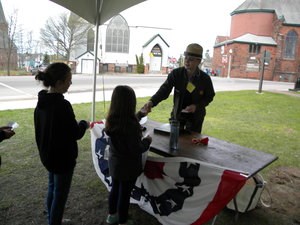
NPS Photo An Immigrant's JourneyEmbark upon a fantastic journey through interactive activities focusing on the many different immigrant groups who came to the Keweenaw Peninsula in the 19th and 20th centuries. By exposing students to art, music, and history of these immigrant groups, they will be able to see how people from different places had different experiences.Michigan Standards 4-G4.0.1, 4-G4.0.2 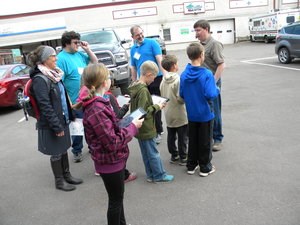
NPS Photo Keweenaw Time Traveler Scavenger HuntStudents will navigate to a given point in pairs, using only a compass for direction. Students will learn that similar methods were used to locate mining permit locations and for open water navigation.Michigan Standards SL.4.1.c, SL.4.4 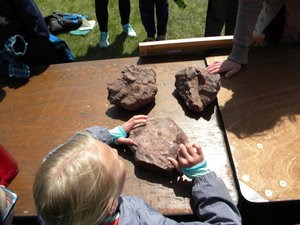
NPS Photo The Keweenaw Rocks!Do rocks stay the same forever and ever? Are the rocks here in the Keweenaw cooler than other places? Students will be introduced to the rock cycle in order to learn about and identify the main rock types in the Keweenaw Peninsula.Michigan Standards 4-ESS1-1 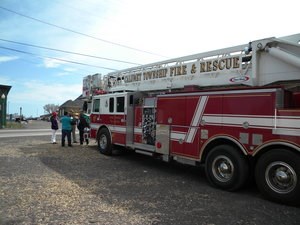
NPS Photo Fighting Fires in 1900If there is a fire today you call 911, but what about fires in 1900? How did people notify a fire station of a fire? What equipment did firefighters use to fight fires? Experience a 1918 fire truck, fire alarm, and more as students travel back in time with the Copper Country Firefighters History Museum.Michigan Standards 4-H3.0.3, 4-G5.0.1 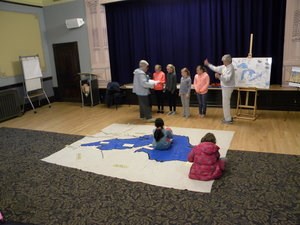
NPS Photo Great Lakes ShippingGreat Lakes maritime transportation made the copper boom of the Keweenaw possible. What kind of ships sailed? How did they get there? What people and materials did they carry? What challenges did the sailors face? Discover the answers to these questions and more as you set sail with the Keweenaw County Historical Society.Michigan Standards 4-G1.0.1, 4-H3.0.1 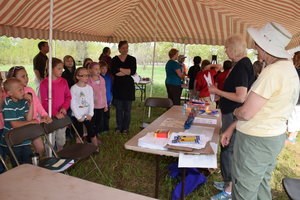
NPS Photo Copper Range Railroad Impacts Life on the RangeAll aboard! Travel back to the 1900s, when the Copper Range Railroad took students from Stanton and Adams Townships to high school in Painesdale. Learn why the train went where it did, listen to stories from people who rode the train, and discover what the former train route is used for today.Michigan Standards 4-3.0.1, 4-H3.0.4 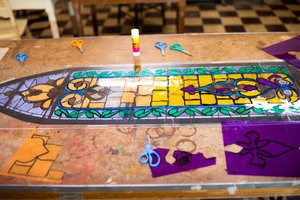
NPS Photo: Victor Ierulli II Stained Glass StoriesStained glass can be found in homes, businesses, and churches throughout the Keweenaw Peninsula. In churches, this stained glass often has a story to tell about those who attended there in the past. The Calumet Art Center, once the First Presbyterian Church, is no exception. After learning about the history of the beautiful windows at the Calumet Art Center, students will discover how stained glass is made and have the opportunity to create their own faux stained glass artwork.Michigan Standards 4-G4.0.2, ART.VA.I.4.4, ART.VA.II.4.4, ART.VA.II.4.5, ART.VA.III.4.2, ART.VA.III.4.5, ART.VA.IV.4.1, ART.VA.V.4.4 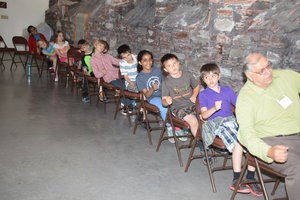
Photo courtesy of Bill Fink Photography Red Rock Wedgers vs. Red Rock BlastersJacobsville Sandstone from the Keweenaw helped build America! Find out how by taking a time machine back to the 1870s, discover what life was like as an immigrant, and learn to do your job as a red rock wedger or red rock blaster.Michigan Standards 4-H3.0.1, 4-G4.0.1 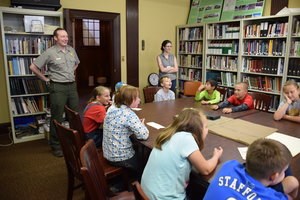
Photo courtesy of Bill Fink Photography Primary Sources: How We Learn About HistoryWhat are primary sources? How do they help us learn about history? Discover what primary sources are, how archivists use them, and compare the past with present through photographs and an old time photo booth.Michigan Standards 4-H3.0.2, 4-H3.0.4 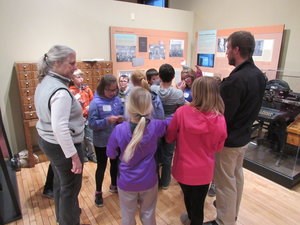
NPS Photo Made for Each Other: Pollinators and PlantsWe all depend on pollinators for much of our food, medicine, clothing, and more. But, who are these pollinators? How have plants and pollinators adapted to one another? Learn about the many forms these relationships take and why they are important to humans.Michigan Standards NGSS 4-LS1-1, CCSS.ELA-LITERACY.RI.4.1, CSS.ELA-LITERACY.RI.4.2 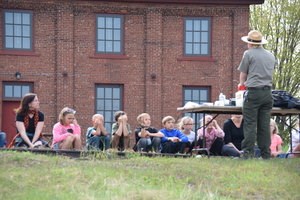
Photo courtesy of Bill Fink Photography Message in a BoxWhat do we as individuals value? How about as a community? Together your class will create a community time capsule and learn how preservation helps us tell our stories to future generations, and how what we choose to preserve tells others what we value.Michigan Standards 4-C5.0.1, 4-C5.0.4, 4-P4.2.2 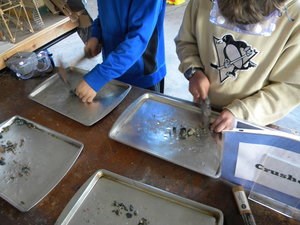
NPS Photo Sorting Quincy CopperHow was copper extracted and separated from poor rock at the Quincy Mining Company? Use your hands to compare the manual and mechanical methods used, and how each contributed to the wealth of the company.Michigan Standards 4-E1.0.1, 4-E1.0.3, 4-E1.0.5 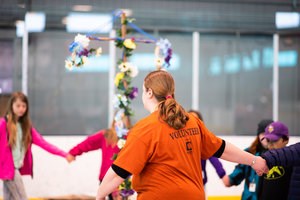
NPS Photo: Victor Ierulli II Scandinavian Midsummer TraditionsCelebrate midsummer early at Copper TRACES this May! Students will use their imaginations to transport themselves to a Scandinavian midsummer celebration. They will gather around the midsummer pole to learn about historical and modern midsummer celebrations, sing seasonal songs, create a small craft project, and more!Michigan Standards: 4 – H3.0.2, 4 – G4.0.2 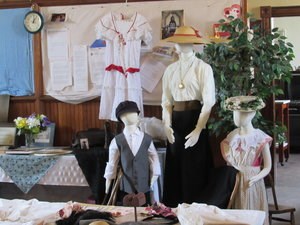
NPS Photo What They Wore: Attending School in the 1910sTravel back in time with your students to an early 20th century classroom in the Calumet area. What was the teacher like? How about the students? Discover the culture of a typical classroom through period clothing, the materials clothing was made out of, and more with the Friends of Fashion. 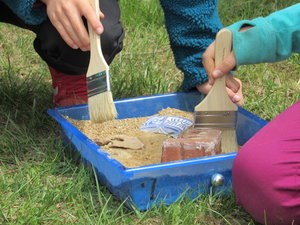
NPS Photo Archaeology - Solving the Mystery on Elm StreetThe vacant lot at 99 Elm Street has been empty since the great fire of 1898. Some people say the old drug store used to be here; others say a large home belonging to a local family stood here. All the town maps and property records were destroyed in the fire. How can archaeology help solve the mystery? What can this vacant lot tell us about life in 1898? Beginning with a research question, students will work in small teams to form hypotheses, gather data from mock excavation and compare/contrast the data with their original hypotheses. Then all teams will share and compare data to reach an answer that best fits the data. Can your team of student archaeologists solve the Mystery on Elm Street? Michigan Standards D2.Geo.5.3-5., D2.Geo.11.3-5., SL.4.1c 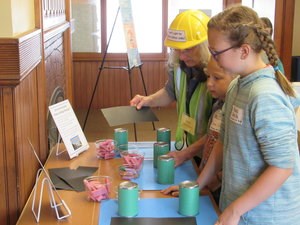
NPS Photo Let's Get to the Other Side!The Portage Lake Lift Bridge is a lifeline that stretches across the Portage Canal connecting the Keweenaw Peninsula. Over time the bridge evolved from a wooden swing bridge to the concrete and steel lift bridge we cross today. What type of engineering goes into constructing a bridge? What types of design constraints did the engineers have here? Explore these ideas and more as your students construct their own bridge over the Portage Canal.Michigan Standards 3-5-ETS1-1, D2.Geo.8.3-5., SL.4.1c 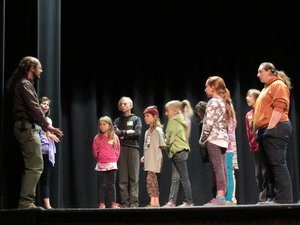
NPS Photo On Stage at the Calumet TheatreSince 1900, audiences have been “wowed” by the acoustics, architecture, history, and overall grandeur of The Calumet Theatre. Despite being a historic theatre, how live theatrical acts are presented today are different than how they were presented in the past. Students will experience the excitement of being on stage at the Calumet Theatre by using the stage as a portal into the art of stagecraft of the past.Michigan Standards 4 – H3.0.4, D2.His.2.3-5., ART.T.IV.4.1 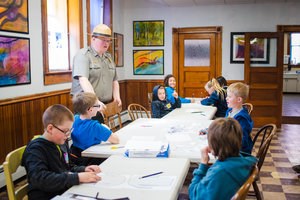
NPS Photo: Victor Ierulli II Jacob A. Riis: How the Other Half LivesJacob Riis (1849-1914) was a pioneering newspaper reporter and social reformer in New York at the turn of the twentieth century. His then-novel idea of using photographs of the city's slums to illustrate the plight of impoverished residents established Riis as forerunner of modern photojournalism. In September and October 2019, Keweenaw National Historical Park will be hosting Jacob A. Riis: How the Other Half Lives, a traveling exhibit sponsored by the National Endowment for the Humanities at the Calumet Visitor Center. At Copper TRACES, students will discover children of the poor at work through a hands-on assembly line that not only explores the meanings of work, but what it might have been like to be a child working at this time in history.Michigan Standards: 4 – H3.0.1, 4 – H3.0.4 |
Last updated: June 16, 2022
